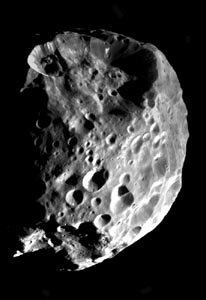
Phoebe a heavily cratered moon of Saturn.
Enigmatic Moon of Saturn
by Paul Doherty
Phoebe was photographed by Cassini as it approached Saturn.

This website was presented as a webcast at the Exploratorium on July 2, 2004. My guest for the webcast was Dr. Eric Wegryn a planetary scientist and teacher from NASA.
Phoebe is the outermost moon of Saturn, 13 million km (8 million miles) from Saturn. It is 32 times further from Saturn than Earth's moon is from earth.
From Phoebe the planet Saturn would appear to be slightly larger (25% larger) than the earth's moon appears from earth.
( Here's the math: Saturn is 10 times the diameter of the earth and 40 times the diameter of the earth's moon, so since it is 32 times further away than the earth's moon is from earth it's angular size in the sky will be 40/32 = 1.25 times the angular size of the moon.)
The bright rings would make a disk 2.3 times the diameter of Saturn circling the planet. Imagine out moon circled by a bright disk making it twice as big in the sky. What a sight that would be!
Phoebe orbits Saturn in the opposite direction from all the other large moons. It is a retrograde moon. It takes 550.48 days to complete one orbit, about 1.5 earth years. It rotates every 9.6 hours. So from the surface there is one sunrise and one Saturn rise every 9.25 hours. It's orbit takes it 30 degrees above and below the rings giving it a good view of the rings.
Phoebe is 220 km (138 miles) in diameter, just large enough that its gravity can pull it into a nearly spherical shape.
Phoebe is dark, it reflects only 6% of the sunlight that hits it. We would say that it is a dark, dark gray. Particularly since the sunlight at Saturn's orbital distance starts out only 1% as bright as sunlight on earth. So the dim sunlight is only partly reflected.
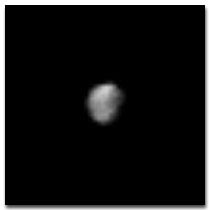
Due to Phoebe's strange orbit scientists think that it is a captured object, perhaps a member of the Kiuper belt. These asteroid-like objects orbit the sun in a cloud that is mostly beyond Neptune. But such objects are occasionally dropped into the inner solar system by stars passing close to the sun. One of them may have been captured by Saturn to become Phoebe. Thus the images of Phoebe would be the first images ever of a Kiuper belt object.
Mapping Phoebe's shape shows that it is more spherical than it appears in this photo. It is 220 km in diameter. The large crater at the top spans about 16 km from bottom to rim, It is nearly twice as deep as Mt. Everest is high.
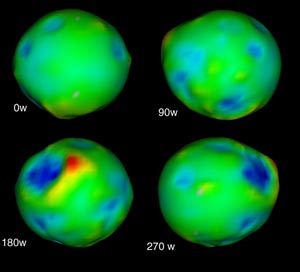
The spacecraft flew close to Phoebe an obtained some excellent views of the moon. There is a fresh looking crater in the top center of this image. In the enlarged image (click on this image to enlarge) you can see black and white layers near the rim of the crater. Perhaps the white layers are ice ejected from impacts elsewhere on Phoebe.
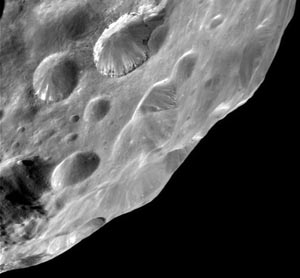
In the above image notice the white streak in the crater wall, perhaps this is ice uncovered by an avalanche.
Observing Phoebe with with an infrared camera reveals its temperature. It is a cold place! Temperatures on Phoebe range from 75 K (-324 F) before dawn to 107 K (-267 F) in the late morning. With cold temperatures like these, Phoebe is definitely a moon that would be comfortable for ice.
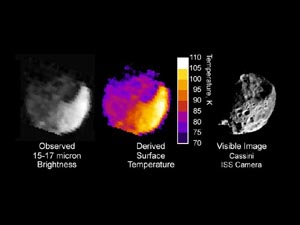
Planetary scientists are analyzing the flood of Data from Phoebe. They will soon know its density. Does it have the density of ice, 0.9 g/cm^3, or the density of rock 3.0 g/cm^3, or some other density indicating a strange composition. we'll soon know. We know its volume from the photographs and its mass from the gravitational deflection of the spacecraft. Combine these and you get the density = mass/ volume.
The infrared camera has also identified some of the materials on the surface of Phoebe: scientists have seen water ice, carbon dioxide ice, iron oxides, and as of now unknown minerals.
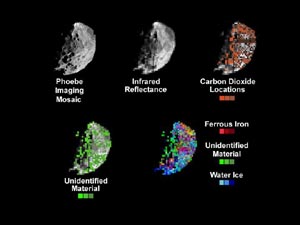
The data acquired by the Cassini spacecraft will be analyzed over the next decade to provide a much better understanding of Saturn, its satellites, its rings, and also of the origin of the solar system.
Phoebe may be a captured asteroid from the Kiuper belt, a "fossil" object from the beginnings of the solar system, time and hard work will tell.
|
Scientific Explorations with Paul Doherty |
|
2 July 2004 |